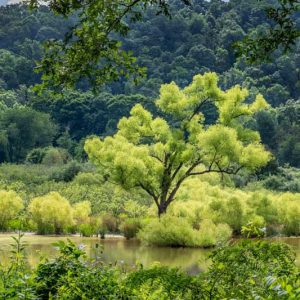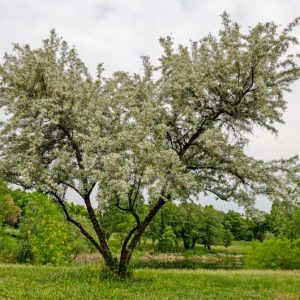Beyond The Weeping Willow: Beautiful & Sustainable Alternatives For Your Yard
There's no denying the enchanting allure of a weeping willow. With their vibrant green leaves gracefully drooping downward, these trees create a truly beautiful and majestic aesthetic in any landscape. Weeping willow trees are well known for their majestic and beautiful branches, which add striking visual appeal, evoking a sense of serenity and timeless beauty. Many homeowners are drawn to their unique form, and it's easy to see why they're such a popular choice for yards and gardens.
Furthermore, the common weeping willow (often Salix babylonica) is often loved for its low maintenance requirements regarding soil. Whether you have loamy, sandy, or even clay soil, this tree is generally tolerant and grows well. The dappled willow, scientifically known as Salix integra, is another very common willow tree that is tolerant of moist soils, making it a go-to for certain wet areas.
However, are you thinking of a weeping tree for your yard but are not quite set on the common willow tree? While their beauty is undeniable, not all landscapes offer ideal conditions for a weeping willow. In fact, there are several compelling reasons why you might want to explore other options. Luckily, a number of other trees can offer similar visual appeal without the potential drawbacks. This article will delve into why alternatives are a smart choice and introduce you to some stunning options that will enhance your outdoor space.
The Allure and The Dilemma of the Weeping Willow
Why We Love Weeping Willows
The visual impact of a weeping willow is truly unique. Their graceful, drooping branches create a distinctive silhouette that can transform a garden into a tranquil oasis. The movement of their leaves in the breeze, the dappled light they cast, and their rapid growth make them an attractive option for those seeking immediate impact and a touch of drama in their landscape. As mentioned, their adaptability to various soil types adds to their appeal, simplifying the planting process for many gardeners.
The Hidden Costs: Why Alternatives Are Needed
Despite their charm, weeping willows come with significant considerations that often lead homeowners to seek alternatives:
- Invasive Tendencies: Perhaps the most critical concern is that Salix babylonica (weeping willow) is listed in the invasive plant atlas of the United States. Invasive plants can outcompete native species, disrupt local ecosystems, and reduce biodiversity. Choosing beautiful natives over invasive plants is a responsible and sustainable landscaping practice.
- Aggressive Root Systems: Weeping willows have notoriously aggressive root systems. These roots seek out water and can damage drainage pipes, septic systems, and even foundations if planted too close to structures. These trees need plenty of room to grow, making them unsuitable for smaller yards or areas near underground utilities.
- Size and Space Requirements: While beautiful, larger willows can grow quite expansive. For sure, you should not plant the larger willows in confined spaces, as they require ample room to develop their full, majestic spread.
- Specific Growing Conditions: While tolerant of various soils, weeping willows thrive in moist conditions and often require consistent watering, especially when young. Not all landscapes offer these ideal conditions, making them a poor fit for drier climates or areas with limited water access.
Embracing Native Plants: A Sustainable Choice
In my last post, I wrote about the importance of using native plants in the landscape. I realize this subject is unfamiliar to many, so I’ll explain more here. Native plants are those that occur naturally in a region without human introduction. They are inherently adapted to the local climate, soil conditions, and wildlife, making them incredibly resilient and low-maintenance once established. The key to this is understanding basic principles of gardening and landscape design, and the specifics involve some plant knowledge.
Native plants can be utilized in the same ways "traditional" plants are, providing structure, shade, beauty, and seasonal interest. By choosing native alternatives, you not only avoid the issues associated with invasive species but also support local wildlife, including pollinators, birds, and beneficial insects. Explore how these trees can create serene environments while supporting local wildlife, and find the perfect fit for your ecological footprint.
While the common weeping willow (Salix babylonica) is problematic, it's worth noting that there are native willow species that can be excellent choices. For instance, Salix bebbiana is a species of willow indigenous to Canada and the northern United States, from Alaska and Yukon south to California and Arizona and northeast to Newfoundland and New England. This native willow offers a similar aesthetic without the invasive concerns of its non-native cousin. Other small willows like Salix purpurea (purple willow) will grow just a few meters, making them suitable for smaller spaces where a willow-like feel is desired without the size or invasiveness of the larger species.
Stunning Weeping Tree Alternatives
If you love the graceful, drooping form of a weeping willow but need an alternative, you're in luck! There are many species of weeping trees similar to the trendy willow tree that offer equally stunning visual appeal and often come with fewer maintenance headaches or ecological concerns.
Trees with Graceful, Drooping Forms
Here are some fantastic alternatives that capture the spirit of the weeping willow:
- Eastern Redbud (Cercis canadensis): While not strictly "weeping" in the same dramatic way as a willow, the Eastern Redbud offers a beautiful, spreading form and stunning seasonal interest. In spring, it's adorned with a profusion of tiny, vibrant pink-purple flowers directly on its branches, followed by heart-shaped leaves. It's a native tree in many parts of North America, supporting local wildlife and thriving in a variety of conditions.
- Weeping Cherry Tree (Prunus subhirtella 'Pendula' or similar varieties): For dramatic floral displays and a truly weeping form, the weeping cherry tree is a magnificent choice. Its branches cascade downwards, covered in delicate pink or white blossoms in spring, creating a breathtaking spectacle. While they require some care, their beauty is unparalleled, and they don't share the aggressive root issues of weeping willows.
- Weeping Birch (Betula pendula 'Youngii' or 'Crispa'): Known for its distinctive white bark and delicate, pendulous branches, the weeping birch offers a different texture and color palette but a similar graceful form. It thrives in cooler climates and provides year-round interest.
- Weeping Larch (Larix decidua 'Pendula'): A unique deciduous conifer, the weeping larch offers soft, green needles in spring and summer that turn golden in autumn before dropping. Its dramatic weeping habit makes it a striking specimen tree.
Alternatives for Specific Landscape Needs
Beyond trees that mimic the weeping form, consider other plant types or landscaping techniques to achieve similar aesthetic or functional goals:
- Evergreen or Deciduous Shrubs: If you're looking for dense, living barriers or privacy screens, evergreen or deciduous shrubs can be excellent alternatives. They create varying levels of formality and seasonal interest, from flowering shrubs to those with colorful foliage. While they won't have the same towering presence, they can define spaces beautifully.
- Training Trees Against a Structure: For a unique and visually stunning living fence or screen, consider training trees against a structure. This espalier technique can be applied to various fruit trees or ornamental trees, creating a flat, artistic display that provides privacy and beauty in a compact footprint.
Choosing Your Perfect Tree
When selecting an alternative, it's crucial to consider your specific landscape conditions, including soil type, sunlight exposure, available space, and your local climate zone. Consulting with a local nursery or landscape professional can help you learn more about the trees that resemble weeping willows and are best suited for your region. Remember to prioritize native species whenever possible to support biodiversity and ensure long-term success with minimal intervention.
While the common weeping willow offers undeniable beauty, its invasive nature and aggressive root system present significant challenges for many homeowners and ecosystems. Fortunately, a wealth of stunning and sustainable alternatives exist. From the vibrant blooms of the Eastern Redbud and Weeping Cherry to the graceful forms of native willows and other weeping varieties, you can find a tree that provides similar visual appeal without the drawbacks. By choosing these beautiful alternatives, you not only create a serene and visually appealing outdoor space but also contribute to a healthier, more balanced local environment.



Detail Author:
- Name : Prof. Trinity Johnson PhD
- Username : etreutel
- Email : adavis@yahoo.com
- Birthdate : 1994-08-10
- Address : 7477 Ryan Club Suite 333 Lynchstad, IN 43036-9580
- Phone : 539-837-0811
- Company : Schmeler LLC
- Job : Community Service Manager
- Bio : Magnam sequi odio rerum. Error nisi consectetur quia tempora et. Placeat atque rerum eos saepe omnis.
Socials
linkedin:
- url : https://linkedin.com/in/rahsaan.jerde
- username : rahsaan.jerde
- bio : Voluptatum culpa aut fugit consequatur nesciunt.
- followers : 6687
- following : 842
tiktok:
- url : https://tiktok.com/@rahsaan1687
- username : rahsaan1687
- bio : Molestiae minima porro numquam id aut.
- followers : 6930
- following : 538